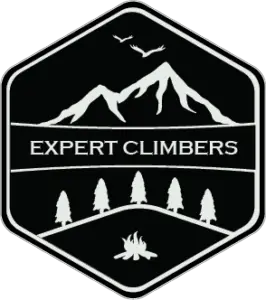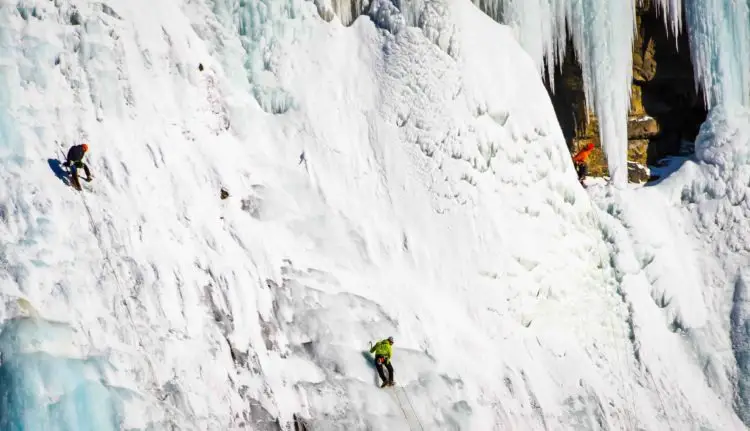The question of how dangerous mountaineering is, requires a bit of a long answer. For starters, it helps to understand what the difference is between it and rock climbing. The short answer is that it includes rock climbing, hiking, ice climbing, and other mountainous activities.
But it’s also much more complex in that mountaineering encompasses a greater variety of skillsets than you’d use in rock climbing, which requires skill in its own right. Mountaineering essentially goes beyond the depths of rock climbing to incorporate ice climbing, endurance, navigation, and survival. It’s more intense and more extreme, which is why mountaineering is considered one of the most dangerous things you can do.
It’s very common for people to die pushing themselves to the extreme in high altitude mountaineering destinations. The dangers abound from the hazards that are already present in nature like avalanches, bad weather, and rockfall, plus there are the hazards that come from the climber. Equipment can fail, and falls from fatigue, poor technique and other subjective hazards are among the dangers you’d face up on the mountain.
Overall though, for those that become mountaineers, their greatest concerns are the imminent dangers of falling rocks, snow avalanches, falling ice, slipping on icy slopes, falls into crevasses, altitude concerns, and changes in weather. You have a much better chance of coming home to tell your tale if you choose a route that’s in the realm of your skills and experience, rather than to risk it all and never come home.
What makes mountaineering so dangerous?
Let’s dig a bit deeper into why mountaineering is so dangerous. Afterall, it doesn’t have the same risks as rock climbing even though they’re a bit similar. Mountaineering is like rock climbing’s crazy cousin that jumps off the balcony at a hotel into the pool after doing a few tequila shots. That cousin may come up from the water cheering, or you may need to call 911. It’s really a crapshoot, like roulette, taking a massive chance just for the thrill of it.
Here are some of the things that can make this extreme sport so dangerous.
– The weather
In many locations where mountaineering is popular, the weather is a huge factor that’s considered an objective hazard in the sport. The weather can appear sunny and warm, with calm winds as you go up and then convert to wild, whipping winds, heavy rainfall, and blizzards where temperatures plummet randomly. For those that have been through this, they’ve called it terrifying. It happens quite suddenly and even with the right equipment, survival is a challenge. No matter what season – even in summer – on the world’s most daunting peaks, these things happen.
Your best bet if you choose to partake in extreme mountaineering is to do the same thing you’d do while rock climbing – prepare. But in this case, you’ll want to learn what to do in case of hypothermia and perhaps bring along gear that could help you rough it. You’ll also want to learn more about avalanches and how to best avoid them, plus what you can do if you think one is about to happen. Another huge danger that most people forget about on the mountainside, with all the terror surrounding avalanches and rock falls, is lightning.
– Falling rocks
When on a crag, you know the more advanced routes can lead you into falling rocks. You’re likely aware to keep watch and be prepared. With mountaineering, falling rocks are still part of the ultimate survival challenge. You’ll do just as you’ve always done during your climbs – watch out!
Joking aside, the dangers of mountaineering are very real and due to the extreme nature of this type of climb, having those jolly old rocks tumbling from above stacks the odds against you in making it to the top in one piece. So, always protect your head and be aware of what’s above.
– Beware of falling ice and icicles
In addition to those rocks you’ve learned to watch for in rock climbing, mountaineering leaves you prone to another type of ambush from above – falling ice and icicles. With those high altitudes and snowy mountaintops, you’re going to encounter them a lot. If you’ve ever had a rock come at you, imagine a sharp, pointy dagger of ice.
I’ve never really been a fan of the cold, so I have no desire to go mountaineering, but if you’re like my best friend who would probably be happiest if he was turned into a polar bear, ice and icicles will ruin your day, and quite possibly, be the last thing you ever get to see in this world.
– Altitude sickness
As a climber, I’ve managed a 5.15 but as someone who has grappled with a fear of heights my whole life, this new phase has helped, yet I’m still not going to go for anything that is out of my comfort zone. Mountaineering I’d put squarely out of my comfort zone.
Once you start getting up there though, higher than I’ve ever been, altitude sickness becomes a major concern. With the lower air pressure and lower levels of oxygen, your breathing rate speeds up. When that happens, the oxygen in your blood gets boosted abnormally. Your body spends this time trying to adjust. But up on the mountainside, dodging icicles and other natural enemies, you have no time for adjustments. You only have time to make your move, and while you do, you could find yourself feeling the effects of that altitude.
Generally, the symptoms of altitude sickness involve headaches, lightheadedness, nausea, and vomiting. These, of course, are not things you want to feel while dangling off the side of one of the world’s scariest mountains.
You can take supplemental oxygen devices along as you’d do at Everest when mountaineers panel up past 8,000m, though some of the more daring mountaineers forge ahead without them, a very dangerous move. Oxygen deprivation scrambles your brain and you need to be level-headed doing something as serious as mountaineering. Your decisions need to be quick and accurate. You have no time for hesitation, for that lingering could be the very last thing you do.
– Other climbers
Just like rocks in rock climbing, other climbers are still as much a danger to you while mountaineering. Overcrowding though is your worst concern. The biggest risk here is when a climber above you slips or falls on you, eventually dragging you down with him. Big mountains like Everest are the granddaddy of them all, and with so many people having something to prove, they get a bit big for their britches. When people become tired, it slows them down, and they lose their sense of balance. Simple mistakes become so much easier to make when mountaineering and the mistakes of others above you can be perilous.
– Crevasses
Crevasses are deep cracks in ice sheets and glaciers. In rock climbing, we have crevices, which are cracks, but not the same thing. Crevasses could kill you and they hide in disguise under the snow. With rock climbing, you want to find those little crevices and fissures in the rock to use them as handholds. But in mountaineering, you don’t want to find crevasses. Much of the time, they’re not even visible thanks to the snow, as the wind blasts them and renders them completely covered.
Crevasses can stretch a long way across on a glacier and the snow on them, referred to as a snow bridge, can often support the weight from one person. Crossing it is very risky though and there have been many events all across the snowy places of the world, where people and even machinery have fallen into them. There really is no trick for avoiding them, except not mountaineering.
– Avalanches
Masses of snow, rocks, and ice that descend down a mountainside at great speed are called avalanches. They happen so fast, but there are warning signs and if you’re daring enough to attempt mountaineering, you should educate yourself about them. Most of the time, avalanches are triggered by the mountaineers themselves or some other climbers on the mountain.
There are snow and ice avalanches though the majority involve dry, powdery snow falling in sluffs. When they fall in this way, it is much less dangerous. But when massive slabs of snow break off from the mountainside and then shatter like glass as they roar downhill. They can move at speeds that go up to 80mph in a matter of seconds, and if they catch up to you, which they will, there’s very little chance that you’ll live through it.
Both types of avalanches are most likely to occur during a snowstorm or the immediate 24 hours afterward. The snowfall is minimally a foot but usually much more and piles up onto snowpacks that build up, layer upon layer, mixed with a hard freeze, rain, and even more snow. If the layers are weak, they have a higher chance of falling.
– Solar radiation
The last thing you’re probably thinking of after reading about all that snow is the possibility of being scorched by the sun. But as it turns out, solar radiation is an even greater concern for you as you climb higher because the atmosphere gets thinner the higher the altitude. So, you’re exposed to more UV radiation.
That snow isn’t just a danger for creating an avalanche that will bring you to your untimely death, but it’s also capable of reflecting UV radiation by up to 75%, which can lead to a sunburn of nasty proportions and also cause snow blindness. And you thought you only had to slather sunscreen on at the crag! Ha!
Conclusion
Because of all these factors that are beyond your control, mountaineering remains one of the most dangerous activities you can ever engage in. The inability to control your environment and the sheer amount of deadly forces that you’ll reckon with, make it a very difficult feat that should never be attempted by anyone less than a seasoned expert, and even then, I think they’re a bit nuts to chance their lives in this way.
As someone who loves rock climbing, I get it; the thrill is just something else! But it’s so much safer than say, scaling up the side of Everest. Over 297 people are known to have died trying to climb the world’s tallest mountain, and I’m not in any rush to go out and join them. With avalanches, altitude extremities, falling things (from people to ice and rocks), and weather conditions that can change in an instant, I’ll stick to my crag and the local climbing gym.

